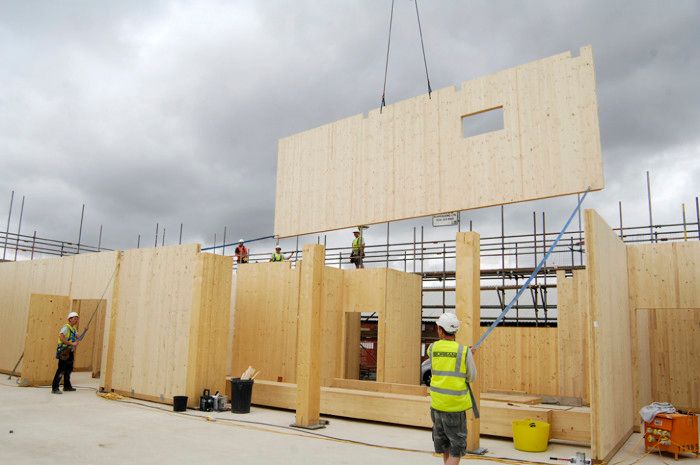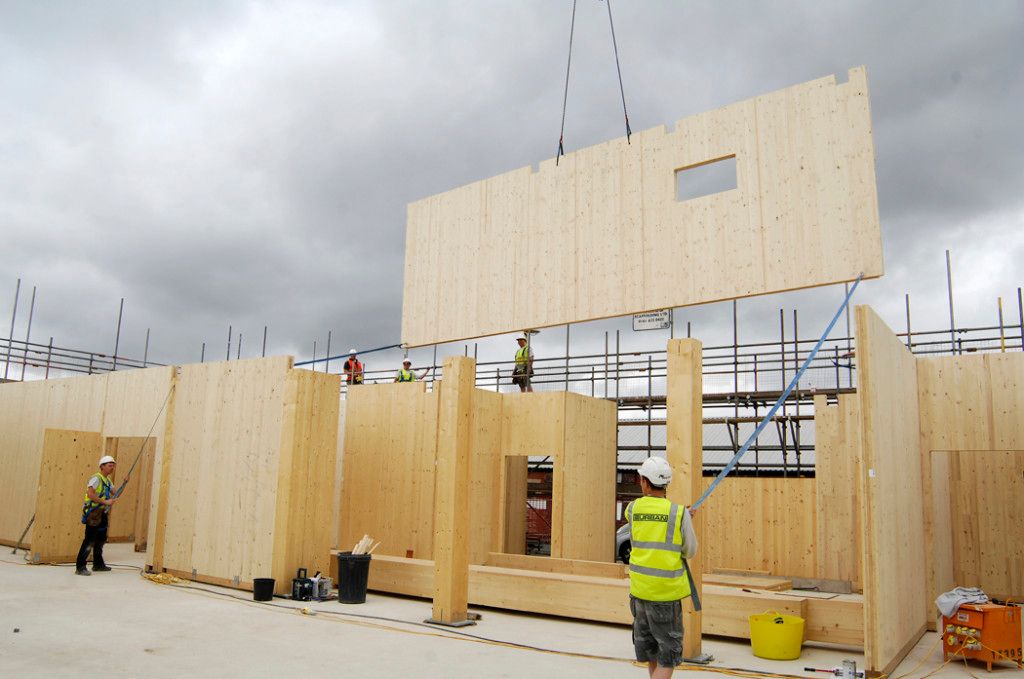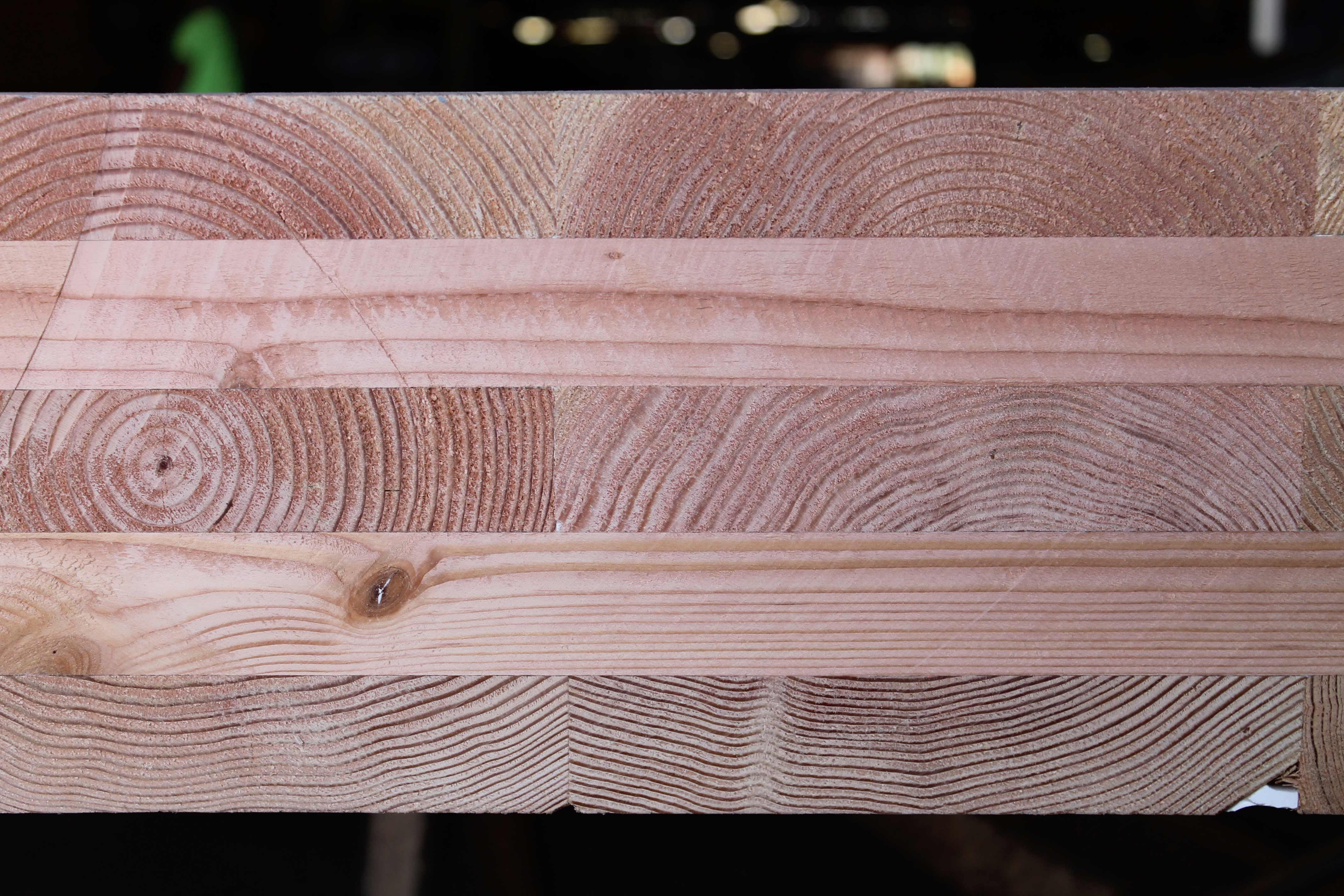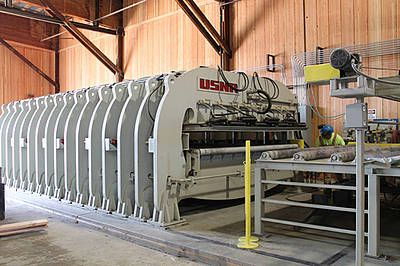
D.R. Johnson, a family-owned timber company in southern Oregon, has become the country’s first producer of cross-laminated timber (CLT) certified for structural applications.
According to an announcement from Oregon BEST, a nonprofit that promotes clean technology, D.R. Johnson is now making panels 24 ft. long that will be used at four construction projects around the state.
Oregon BEST last year gave $150,000 toward research on this emerging technology at Oregon State University, and to help develop a production line at the D.R. Johnson mill. In addition, Business Oregon, the state’s economic development agency, is loaning the mill $100,000 to offset the costs of ramping up production.
The company makes the panels in a press designed by USNR, a Woodland, Wash., firm, and built by D.R. Johnson employees in the mill’s fabrication shop (see the photo below). The panels will go to four projects around the state, including ones at Western Oregon University and a bank in Portland.
D.R. Johnson manufactures panels with Douglas fir, harvested primarily in Oregon, and a melamine glue from Akzo Nobel called Greenguard Gold. The maximum panel size is currently 10 ft. by 24 ft. with a maximum thickness of 9-5/8 in. The company plans to install new equipment that would extend the press early next year.
Wood as an alternative to concrete
The announcement comes at a time of increased interest in replacing concrete and steel, the conventional building blocks of modern commercial buildings, with timber. Promoters of timber construction, already successful in Europe and Australia, say timber panels produce fewer greenhouse gas emissions, can shorten construction schedules, and may even be cheaper than conventional concrete-and-steel buildings.
CLT buildings of nine and 10 stories have been constructed elsewhere, but the technique is very new in the U.S.
Hines Interests LP, a real estate company based in Houston, announced in July that it had broken ground on a seven-story, all-timber office building in Minneapolis. The 220,000-sq.-ft. building–called T3 for its emphasis on timber, transit, and technology–is being built on spec and without any tenants lined up in advance, The Star Tribune said in an article.
Michael Green Architecture, experts in heavy-timber construction, was hired for the project. T3 is expected to be complete in about a year and will be the tallest modern all-timber building in the country.
In a TED talk in 2013, Green discussed his affinity for wood construction, and said it would prove critical in building structures that do not contribute to climate change. Steel and concrete, he said, together produce 8% of the planet’s total greenhouse-gas emissions, while timber construction sequesters carbon dioxide. Wide-scale adoption of wood-panel construction would not contribute to deforestation, he said, and timber buildings are not fire hazards.
Wood also has a tactile quality that steel and concrete do not, Green said. He said he’s never seen anyone hug a steel or concrete building component, while people walking into buildings made from wood actually have.
Green thinks buildings of up to 30 stories can be made with “mass timber panels,” although construction of wood skyscrapers is now limited by “arbitrary” restrictions. He said he looks forward to an “Eiffel Tower moment” of innovation that would clear the way for more timber construction.
“We’re at the beginning of a revolution, I hope, in the way we build because this is the first new way to build a skyscraper in probably 100 years or more,” he said. “But the challenge is changing society’s perception of possibility and it’s a huge challenge. The engineering is truthfully the easy part.”
A blend of wood, concrete, and steel
According to a report posted at ConstructionDive, the foundation of T3 will be concrete to meet local building codes, and a steel frame will make connections between wood components. But the buildings core and floor plates will be made from engineered wood panels. Likewise, structural columns will be made from engineered wood.
Many of the pieces can be built off-site and assembled quickly once they’re trucked in, making for faster construction schedules.
Melbourne, Australia, claims the world’s tallest timber structure, a 10-story apartment complex which took 10 weeks to build and was completed three years ago. In London, a nine-story building whose floors, ceilings, elevator shafts, and stairwells all are made from wood, was opened in 2009. Popular Science reports that Swedish authorities have approved plans for a 34-story wood tower in Stockholm while a Chicago architectural firm has published a feasibility study for a 42-story tower made mostly of CLT.
Read more: http://www.greenbuildingadvisor.com/blogs/dept/green-building-news%2A#ixzz3lvhtf85Q
Follow us: @gbadvisor on Twitter | GreenBuildingAdvisor on Facebook
Fine Homebuilding Recommended Products
Fine Homebuilding receives a commission for items purchased through links on this site, including Amazon Associates and other affiliate advertising programs.

8067 All-Weather Flashing Tape

Affordable IR Camera

Handy Heat Gun





















